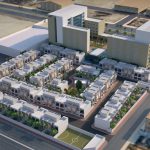
The Visionary Perspective: Urban Planning for Smart Cities
November 9, 2023
Embracing Resilient Design: Building for a Changing Climate
January 1, 2024
Front view of real estate agent stacking wooden dices with house symbols on them in a conceptual image.
Introduction:
Welcome to my blog, where I share my perspective on the powerful impact of real estate in driving economic development, particularly through urban revitalization and job creation. With a deep passion for transforming communities and creating opportunities, I believe that real estate projects hold immense potential to reshape cities, attract investments, and generate sustainable growth. Join me as I delve into the transformative role of real estate and share my insights on unleashing its power to revitalize urban areas and foster economic prosperity through job creation.
Real Estate: An Engine of Job Creation:
Real estate development goes far beyond constructing buildings; it fuels job creation at various stages of the project. From the initial planning and design phases, which require the expertise of architects, engineers, and urban planners, to the construction phase that employs skilled laborers and tradespeople, real estate projects provide significant employment opportunities. Moreover, once completed, these developments give rise to operational roles, such as property management, retail operations, and hospitality services, creating a ripple effect of employment opportunities within the community.
Urban Revitalization: Breathing New Life into Communities:
One of the most rewarding aspects of real estate is its potential to revitalize urban areas that have experienced neglect or decline. By repurposing underutilized spaces, restoring historic buildings, and transforming derelict sites, we can breathe new life into communities and attract residents, businesses, and visitors. This rejuvenation not only enhances the physical landscape but also sparks a sense of pride and renewed hope among community members.
Attracting Investments and Driving Economic Growth:
Real estate projects act as magnets for investments, driving economic growth and prosperity. When developers create vibrant commercial and mixed-use spaces, they attract businesses, entrepreneurs, and investors who see the potential for growth and success. This influx of investments stimulates the local economy, creates employment opportunities, and generates tax revenues that can be reinvested in further urban development initiatives.
Social Impact: Building Sustainable and Inclusive Communities:
Real estate development must be approached with a deep sense of social responsibility. It is our duty as developers to consider the needs and aspirations of the community, fostering inclusivity and sustainable practices. By incorporating affordable housing initiatives, community spaces, green infrastructure, and sustainability measures, we can create environments that uplift the lives of all residents and contribute to a more equitable and environmentally conscious future.
Conclusion:
Real estate has the power to transform not just physical landscapes but also the economic and social fabric of communities. Through job creation, urban revitalization, attracting investments, and prioritizing sustainability and inclusivity, real estate projects can unlock immense potential for economic growth and community well-being. As we navigate the realm of real estate development, let us embrace the opportunity to make a lasting impact, building vibrant, prosperous, and sustainable communities that stand as testaments to our vision and commitment to a better future.


